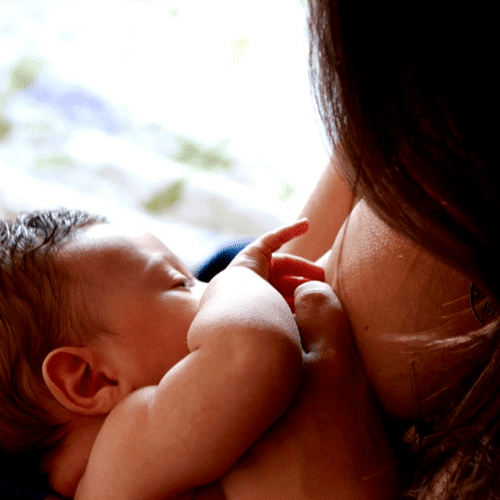If you’re wondering how long breast milk can be stored for then, the answer is eight days! That’s in a refrigerator, without warming it up. It must be fresh and not stored and rewarmed for it to last this long.
It can be such a long process with pumping and storing breastmilk. Its definitely hard work.
Of course, because of this, you want to make sure that none of your precious goods go to waste.
You want to ensure that every last bit has been taken in by your little one.
Moms tend to become worried that the milk isn’t going to be good enough when left out, and so, it’s wasted. This isn’t always the case.
As an Amazon Associate I earn from qualifying purchases. The links below may be affiliate links. Please read my disclosure policy for more information.
Before expressing or handling breastmilk:
• If you’re using a pump kit that’s shared, you should clean the power switch, pump dials, and counter top to ensure that it is thoroughly disinfected.
• Wash your hands thoroughly with soap and water. If you haven’t got soap and water available, you can use a hand sanitizer, which is alcohol-based, so it should contain at least 60% alcohol.
• If you’re using a pump, ensure that the kit and tubing is clean. If you find any molding tubing, discard and replace it immediately.
• You can choose between hand expressing or with a manual or electric pump.
You May Like: 11 of the Biggest Breast Pumping Mistakes?
Which breast milk storage method is best?
It doesn’t matter how you decide to feed your baby, whether it be a bottle or breast.
Although, there are so many claims that the breast is better than the baby formula.
If you have freshly expressed, it is preferable to store it in the fridge instead of the freezer.
If you put your breastmilk in the refrigerator, it will have more bacteria-fighting properties and is higher in vitamins, fat, and antioxidants than the milk that would be kept in your freezer.
Related: How to Make Breastmilk Lotion
How long should expressed milk be stored?
You can store your breastmilk either in the freezer, fridge or at room temperature; it all depends on how soon you’d like to use it and how much of a milk backlog you have.
If you’re planning to store your breastmilk at room temperature, which is anywhere from 60 degrees Fahrenheit to 25 degrees, then you’re able to store the milk up to 4 hours.
If you have followed the guidance for cleaning and sanitizing your breast pump and you’ve expressed under immaculate conditions, the safe storage time for milk at room temperature is up to 6 hours.
The safe storage time for breastmilk in a refrigerator is up to three days or five days under clean conditions. The fridge must be 39 degrees Fahrenheit or colder.
Storing your milk in the freezer, which should be 0 degrees Fahrenheit or colder, can be up to six months or nine months if the expression was done under immaculate conditions.
If you’ve frozen breast milk and it’s been thawed in the fridge, it can last up to 2 hours at room temperate or up to 24 hours if you want to leave it in the refrigerator. Just remember that you cannot refreeze once it’s been thawed.
Related: Best Bassinet for Breastfeeding

Related: Learn how to Exclusively Breast Pump like a Pro in Just 90 Minutes
breast milk storage tips:
• You can store your breastmilk in an insulated cooler bag with ice packs inside for up to 24 hours if you’re traveling. As soon as you arrive at your destination, your breastmilk should be used straight away, stored in the fridge or frozen.
• Remember not to store your breastmilk in the fridge door due to the inconsistent temperatures due to the opening and closing of doors.
• If you’re unsure whether you’ll use your breastmilk within four days, you should freeze it as soon as possible. This will help to keep the quality of the milk at its best.
• If you’re giving your breastmilk to a childcare provider, then make sure you add a clear label on the container with your child’s name.
• Ensure that you talk to your childcare provider about any requirements you might have in regards to the storage or labeling of your breast milk.
• Make sure the date of expression is clearly labeled on your breast milk container.
• Freeze your breastmilk in amounts of 2-4 ounces, or however much will be offered in one feeding, so you minimize the amount wasted.
• Leave an inch of space at the top of your storage container when you freeze breastmilk because it will expand when it’s frozen.
Related: How To Build A Freezer Stash

Mama of Five Recommends:
| Product Name | Features | Check Price |
|---|---|---|
| MEDELA PUMP IN STYLE ADVANCED FOR DOUBLE PUMPING | • Mothers can produce more milk in less time; this breast pump was made for optimal efficiency and maximized flow • For portable, discreet pumping • Single knob speed/vacuum adjustments, for comfortable pump settings • Removable cooler bag with contoured ice pack: Holds 4 breast milk bottles and ice pack to keep breast milk bottles cool • All parts that touch breast milk are made without BPA: Safe for you and your baby | Check Price here |
| HANDS FREE SIGNATURE BRA | • Freedom for you to work on tasks or simply relax while pumping. •Comes with an adjustable Velcro back panel to ensure a perfect fit. •Works with all major brands. | Check Price here |
| ORGANIZER CONTAINER BIN FOR BREAST MILK POUCHES | • Perfect for storing all of baby’s Breast milk • Built-in, easy-grip side handles make it convenient to pull these off the shelf • Made of durable BPA and Chlorine free shatter-resistant plastic | Check Price here |
| LANSINOH BREASTMILK STORAGE BAGS, 100 COUNT | • Breastmilk storage bags are ideal for storing, freezing and protecting precious breastmilk. • Double zipper seal to prevent leakages and reinforced double sealed side seams for ultimate protection. • Pump directly into Lansinoh breastmilk storage bags for convenience and reduced waste. • Stand or lay flat for compact storage. Easy to use with write-on label and convenient pour spout. | Check Price here |
Related: Super Foods for your boobs: FOODS THAT WILL INCREASE BREAST MILK SUPPLY!
How to store breast milk in the fridge
To store your breastmilk in the fridge, follow these guidelines:
• Store your breastmilk in the coldest part of the refrigerator, which will be at the back. Simply place the milk on the shelf, which is above the vegetable compartment. If you decide to store it in the fridge door, you’ll come to realize that the temperature is less consistent, and the milk might not last as long.
• Put your expressed milk in the fridge as soon as possible.
• If you have milk already in the fridge that has been cooled in the refrigerator beforehand, you can add small amounts of newly expressed milk to the same container. Although, you mustn’t add milk that is at body temperature to milk that is cooled.
• Your breastmilk must be stored in clean breast milk bottles or storage bags, which are made from BPA-free materials. BPA is phasing out as it has been widely used in plastic containers and coatings. This is due to it being a chemical and having some uncertain long-term effects.
Related: How To Build A Freezer Stash

How to store breast milk in the freezer
If you’re looking to store your milk safely in the freezer, read on:
• The temperature at the back of the freezer is more consistent and should be where you store your milk. If you have a self-defrosting freezer, keep your breastmilk away from the walls.
• As soon as you’ve expressed, you should put your milk in the freezer if that’s your chosen storage method.
• If you’ve expressed some milk and have room in an already frozen bag of breastmilk, then you can add it in, but it must’ve been cooled in the fridge beforehand. Never add body-temperature milk to frozen milk.
• Breastmilk expands during the freezing time, so don’t fill the bottles or bags up any more than a three-quarter full.
• Store your milk in small portions of less than 60ml, so you have more effortless thawing experience and not much wastage. You’ll then be able to combine them once defrosted.
• You should always ensure that your breastmilk storage containers can be used in the freezer as if they have a particular type of material (such as glass) it might crack at freezing temperatures.
Related: Breastmilk Storage Guidelines made Simple.
Tips for storing breast milk at room temperature
• Keep your breastmilk away from heat
• Place a cold towel over your storage container
• If your room temperature is greater than 77 degrees Fahrenheit, don’t sit your milk out in it.
Put a cap or top onto your breastmilk storage bottle or seal the storage bag.

Safe thawing of breast milk:
• Never refreeze your breast milk once it’s already been thawed
• Thaw the oldest breast milk first. So, it’ll always first in and first out. This is because, over time, the quality of your breast milk can decrease, so rotation needs to happen.
• Once your breast milk has been brought to room temperature or you’ve warmed it after its been in the fridge or freezer, it should then be used within 2 hours.
• You can thaw your breast milk in different ways such as under lukewarm running water, in the fridge overnight, or set in a container of lukewarm water.
• Breastmilk should be used within 24 hours after thawing in the fridge. This is from the time that it is completely thawed, not from when you took it out of the freezer!
• Do not heat frozen milk in the microwave; this will take the nutrients in the milk and can burn your baby’s mouth due to forming hot spots.
Related: How to Pump while breastfeeding
Feeding expressed breast milk:
• If your baby didn’t finish the bottle the first time, then the left-over expressed breast milk should be used within 2 hours. Once those 2 hours are up, you should discard the milk.
• You don’t need to warm up the breastmilk. It can be served room temperature or even cold.
• If you decide to warm breast milk, you should keep the container sealed while it’s being warmed, do not heat directly on the stove or microwave, and remember to test the temperature before feeding it to your baby. This should be done by putting some on your warm.






